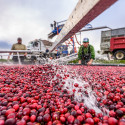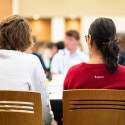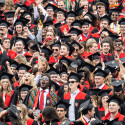UW Tech Exploration Lab student projects highlight innovation, emerging technologies
At a recent open house for the University of Wisconsin–Madison’s Tech Exploration Lab at the Wisconsin Institute for Discovery (WID), Alzheimer’s app creator Aarya Deshpande was continually approached by individuals eager to connect with him and to share their personal or familial struggles with memory decline. A junior in computer science and data science, the idea for his app was inspired by a relative who has Alzheimer’s.
“There were so many people,” says Deshpande, still somewhat in disbelief. “It really made me feel connected with all these other souls.”
Bold ideas, creative problem solving, and community impact drive the 24 student projects launched and celebrated this past semester at the Tech Exploration Lab, a partnership between the Wisconsin School of Business and WID. Some of the projects are completed, but many are continuing on; all integrate a real-world challenge with emerging technologies and mentorship from UW–Madison alumni—underscoring the Wisconsin Idea that education’s benefits should extend beyond the boundaries of the classroom.
Here are three of their stories.
Cub Foods and Crystal Farms Dairy Company
Optimizing promotion with AI

Can AI’s capabilities improve even a product as beloved as Wisconsin cheese?
Yes, say project leader Tiancheng “Albert” Wu and his four teammates, or at least AI can enhance the promotion behind the dairy favorite.
Wu and his team, all UW–Madison freshman in computer science and data science, worked on a retail trade promotion project for two Midwestern industry giants. Throughout the project, they collaborated with the companies’ leaders: Tim Bratland, president of dairy producer Crystal Farms, and grocery chain Cub Foods’ CIO, Luke Anderson.
“The problem we address is that packaged good companies such as Crystal Farms and Cub Foods often rely on dedicated product managers with extensive experience in a certain type of product to come up with different promotion strategies,” Wu says. “What if we could take it one step further and leverage machine learning to help with this?”
Using customized pipelines and optimization techniques, the team built and integrated three different analytical models based on the “vanilla” (non-customized) version of Google’s LLM, Gemini. Wu’s team then ran a “what if” analysis on different trade scenarios using historical data from Crystal Farms’ cheese promotions. The results: The combined model bested Gemini by 10–15%, and the team built an app designed for stakeholders so they could run analyses on future spending scenarios to see what was economically feasible. “We demonstrate that with proper customization, powerful LLMs like Gemini have the potential to empower regional businesses with a similar level of analytic capacity without incurring enormous cost,” Wu says.
Wu says the team is grateful to have the opportunity to partner with Bratland to have a taste of what it’s like to work in a “real-life business scenario” and that they’re “very proud of what we have achieved.”
Bratland agrees. “As a small company navigating the challenges of innovation, especially around AI, the UW Tech Exploration Lab offered us something incredibly rare: a risk-free space to experiment, learn, and move forward,” he says. “Through our partnership with the lab, we were able to test real use cases, collaborate with sharp student minds, and gain hands-on experience that translated into tangible insights that we could apply to our business. The learnings we gained here accelerated our AI journey; it was the spark we needed to look at our business differently through the use of AI.”
Future plans: Wu and his project team look forward to a continued relationship with Crystal Farms and Cub Foods through the lab. They hope to continue to finetune the model’s accuracy, and to expand it to include both similar products, such as cheese’s frequent companion, jam, as well as competing products.
Ember AI
Keeping firefighters and communities safe
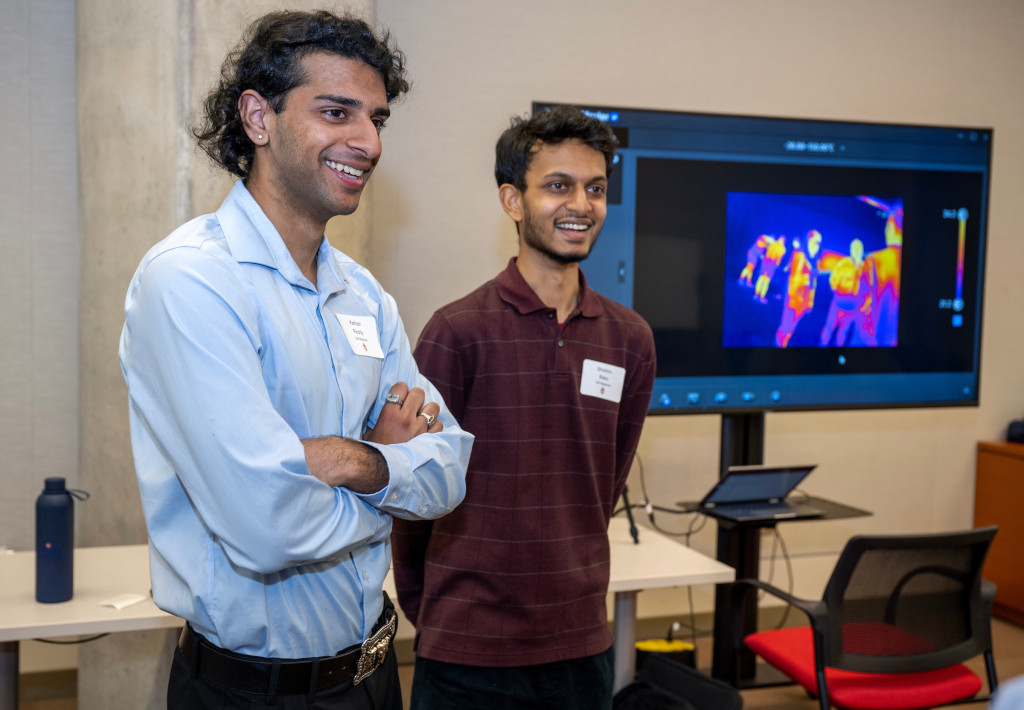
Along with the rest of the world, Kathan Reddy and Shobhin Basu witnessed the tragedy of the Los Angeles fires as it unfolded.
“As we watched the footage, we noticed that one of the factors that made it more complex to fight was the fact that there were small spot fires and that embers were flying in unpredictable directions and starting other fires in combination with winds,” says Basu. “So, we wanted to develop a tool that could help firefighters with the unpredictability of spreading embers.”
Both juniors in computer science, project partners Reddy and Basu created an algorithm using computer vision, a type of AI, to identify and track stray embers. The AI algorithm is used in conjunction with a thermal imaging camera, provided by the Tech Lab, that maps heat. For now, the pair feeds the algorithm raw data images—such as that of a burning campfire—to get blob detection that pinpoints where the embers are. Once the project scales up for the real world, this process would occur on a large, helicopter-mounted camera so firefighters can survey the scene from above, says Reddy, adding that they both view this venture as filling a humanitarian need, not something they plan to commercialize.
They watched hours of YouTube videos on AI, but “none of it translated to our project,” says Reddy. “If you’re inexperienced, you don’t know the project flow and how it goes to make things on your own. We would spend hours going in sideways directions.”
Luckily, the Tech Lab’s Kevin Ponto was available for help. “Every time we talked to Kevin, we instantly made like two weeks’ worth of progress within one meeting,” Reddy says. “He has a ton of projects under his belt, and he understands how these things go. He understands the logistics and where we are in the project.”
Reddy and Basu also benefited from the Tech Lab’s weekly visits from industry experts. “One of the reasons I first got into this project was so that I could learn a lot of new things,” Basu says, “and that really excites me going forward, thinking about all of the other things that I can do with this knowledge.” Both plan to continue with the project in the lab’s summer program.
Reddy says that working on Ember AI has given them confidence to execute other ideas in the future.
“The idea that you can follow your passion is an idea that I’m very enamored with right now,” he says.
Having full creative control—and total responsibility—has its own unique appeal.
“I’ve learned that people who have finished products care about them a lot because they’ve taken these projects from such a small place. To show even the most basic thing we have takes so much love,” Reddy says. “I’ve been talking about fire for two months straight.”
Future plans: The next iteration of the project would be to work with larger fires. Thanks to the Tech Lab’s contacts with area fire and police departments, the project may advance to staged house burns and footage from drones.
Alzheimer’s app for caregivers
Creating a digital life storybook for patients and their families
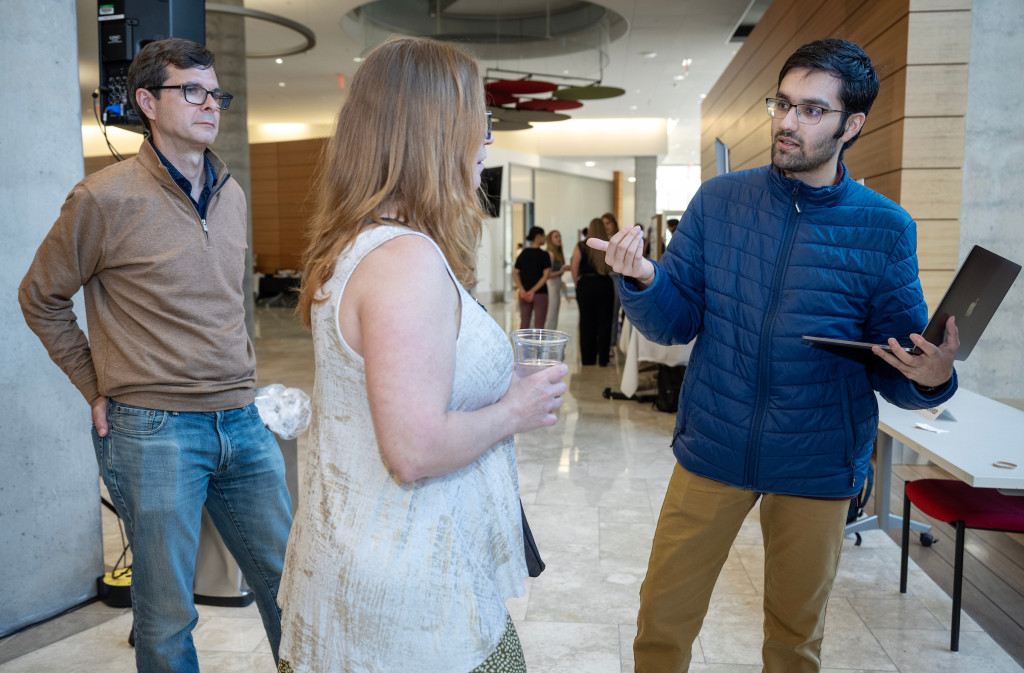
A mock-up of Deshpande’s Alzheimer’s app for caregivers, “Hatti for Alzheimer’s,” shows colorful icons of an elephant and a brain, and comforting copy, “The elephant remembers for you.”
Hatti in Hindi means “elephant,” a species known for its long memory. While it’s just a working title and slogan so far, says Deshpande, “that’s kind of the motto that the app is based on, that it can offload some of the stress and the burden not only for the person with Alzheimer’s, but also for their caregivers and family members.”
Other features within the prototype show where the user can add photos of family members and details of their relationship to the user, as well as cherished memories. A white dress, for example, can trigger a wedding memory for the individual with dementia. Deshpande hopes to make the app responsive: If an image causes distress, the app could switch it out for a calming alternative.
“The goal is for the app to not only hold treasured memories like this, but to also respond dynamically by adapting content based on emotional cues and behavior, with AI models that help identify what brings calm, what sparks stress, and what re-engages the mind,” he says. Other attributes include an innovative game to spur the Alzheimer’s individual’s working memory and potentially an area where individuals with memory loss could record their thoughts “as audio, digital sticky notes,” says Deshpande, to recall later.
“It’s not only memory recall that I’m trying to provoke,” Deshpande says. “I’m also trying to bring a sense of calm and happiness, some sort of joy, too.”
Deshpande first had the idea for the app during his senior year in high school, but “the momentum really began when I started college at UW–Madison and started connecting with everyone,” he says. “That’s when it really started growing forward.”
Deshpande says he considers the app to be “interdisciplinary,” with both a “health side and a research side.”
Through his own research, Deshpande created the initial prototype for the app and connected with Jon Eckhardt, Pyle Bascom Professor in Business Leadership at WSB and Special Advisor to the Chancellor for Entrepreneurship. Eckhardt encouraged him, putting him in touch with four UW–Madison senior dementia scientists who offered guidance and feedback. More recently, he was named a Wisconsin Science and Computing Emerging Research Star (WISCERS) awardee, working under Professor Suman Banerjee on aspects of the AI-powered features of the app such as speech-based memory resurfacing and personalized content selection guided by caregiver input. Deshpande also credits Associate Professor Andrea Gilmore-Bykovskyi with what was a “huge pivot” from the app’s original quiz-like format to focusing more on the emotional side including music, a “reminiscence and life-story system” that would better benefit those living with Alzheimer’s.
Deshpande says the Tech Lab also helped connect him with users for validation including the Center for Healthy Minds and their Healthy Minds app.
“What’s nice is it’s almost like I’m building a ‘Healthy Minds’ but for Alzheimer’s,” he says. “With the connections I’ve made in the Tech Lab, it’s really inspiring to see other students working on adjacent areas, too. It’s like the Tech Lab is providing this triangle of innovations that are echoing and inspiring one another.”
Future plans: Deshpande will present his research findings at Duke University this summer and hopes to start piloting the app at several memory care centers. He also is taking part in the lab’s AI Venture Ready program this summer to validate with customers, test business models, and assess market readiness.

